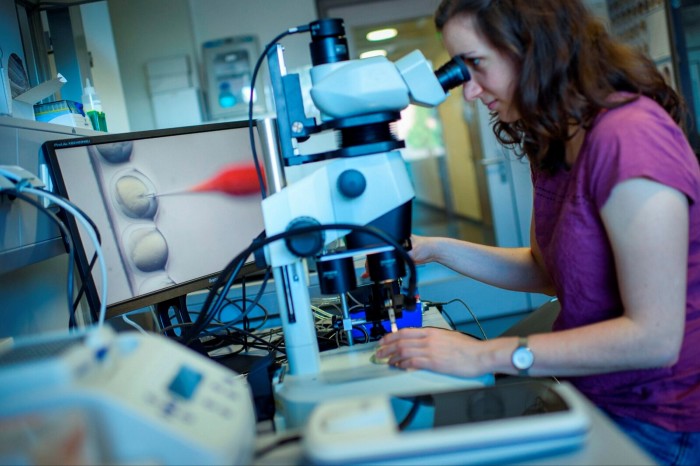Just a decade after Crispr was invented, the first drug to make use of the revolutionary gene-editing technology will be with regulators by the end of the year, with the promise that it will eventually transform the treatment of genetic diseases.
In 2012, Nobel Prize winners Jennifer Doudna and Emmanuelle Charpentier published a scientific paper proving a key part of the bacterial immune system could be used to cut DNA: disrupting, deleting or correcting genetic errors.
Their discovery started a race by start-ups to create transformative — and possibly even curative — treatments, which has developed much faster than previous advances in biology.

The first to close in on success is Crispr Therapeutics which, in partnership with biotech group Vertex, expects to submit late stage trial data seeking approval for its treatment for the inherited blood diseases sickle cell anaemia and beta thalassaemia to EU and UK regulators at the end of 2022.
Its latest data show all sickle cell patients were free of symptoms and that the vast majority of beta thalassaemia patients were no longer reliant on transfusions.
Doudna said it was “extraordinary” that sickle cell patients such as Victoria Gray, who was treated in the first trial three years ago, have already been “effectively cured of genetic disease”.
“One of the most surprising and exciting things to me is just how rapidly it’s been possible to apply it in the clinic,” she told the Financial Times. “It has been the foundation for multiple companies, created tens of billions of dollars in value, and many, many thousands of jobs.”
Accordingly, big pharma groups like Pfizer, Bayer and Regeneron have taken note, forming partnerships with the pioneers. Analysts predict drugmakers will soon be in the market to buy Crispr companies, partly in the hope of acquiring the tool to improve innovative treatments for cancer.

But the development of Crispr also raised significant questions about the ethics of gene editing and its long-term effects.
Many scientists condemned a Chinese researcher who revealed in 2018 that he had edited the genetic code of recently born twin girls. There have also been intellectual property lawsuits, debating the relative contributions of Doudna and Charpentier, and the Broad Institute’s Feng Zhang, who wrote a paper showing how Crispr works in humans.
For the start-ups working on Crispr drugs, the general slump in biotech stocks, some failed trials and safety concerns in the adjacent field of gene therapy, have made life more difficult. It has become harder to convince investors that this revolution has staying power.
And when the first Crispr drugs are approved, there is the question of persuading insurers and governments to pay the high price tags, just as drug pricing reform is back on the agenda in the US, the world’s largest pharmaceutical market.

Biotech’s “transistor” moment
Vijay Pande, a general partner at venture capital firm Andreessen Horowitz, compares Crispr to the invention of the transistor, which revolutionised computer design.
“We are just at the very earliest stages. I think where we are now is maybe akin to the 1960s in computers,” he said.
The biggest remaining scientific challenge is delivering Crispr to other organs, beyond the relatively easier areas of the blood, liver and eyes. Kiran Musunuru, a gene editing specialist at the University of Pennsylvania, said researchers are already starting to make some progress.
“It’s going to blow up in the next 10 years,” he said. “That’s going to be transformative because it is going to greatly expand the number of diseases that we can treat with Crispr in patients.”
Crispr’s scientific success is partly because it can use or adapt technology developed and applied in gene therapy, a method of delivering missing genes to patients that has been used to treat life-threatening conditions like spinal muscular atrophy.
It has also benefited from the explosion of data on the human genome, which helps scientists understand which genes to target.
“The thing about Crispr that’s so remarkable is that the timing was right,” Doudna said.
Scientists quickly built on the original discovery. About five years ago, they created base editing, which can make more precise changes. Pfizer has partnered with base editing company Beam Therapeutics in a deal worth up to $1.35bn, hoping to deploy its expertise in lipid nanoparticles, developed from its work on the Covid-19 vaccine, as a way of delivering Crispr treatments.
While most trials are still targeting rare diseases, base-editing company Verve recently treated its first patient in a study targeting a genetic condition that causes high cholesterol, which could one day be used in a market of millions of patients.
Crispr is also being used to enhance a type of individually tailored cancer treatment called CAR-T therapy, which could be what tempts pharmaceutical companies into acquiring smaller specialist biotechs, according to Jefferies analyst Maury Raycroft.
Big pharma groups are sitting on huge cash piles and a number of them need to build up their drug pipelines before significant patent expiries at the end of the decade.
John Leonard, chief executive of Intellia, which did the first in-body Crispr delivery (rather than removing cells, modifying and returning them) as part of its trial for a liver disease treatment, said it is “essentially a foregone conclusion” that every large pharmaceutical company will have to have some Crispr capability.
Healthy scepticism
Not everyone is convinced. After a buoyant two years during the pandemic, the whole biotech sector is suffering. Generalist investors are less focused on healthcare and specialists are worried that too many companies went public too early, often without any clinical data.
The Nasdaq biotechnology index fell by 21 per cent in the past year — but Crispr companies are down further. Shares in Intellia have fallen 61 per cent in the past year, Verve by 42 per cent, Editas stock is down 73 per cent, and Beam Therapeutics and Crispr Therapeutics have lost about 40 per cent of their market capitalisation each.

Nooman Haque, Emea managing director of life science and healthcare at specialist lender Silicon Valley Bank, said 2019 and 2020 were record years for the sector, and for gene therapies in particular, but now investors are coming to realise there are still challenges ahead.
“There’s a realism that while the technology might be wonderful and awesome, the cold hard reality of the business is what am I going to get paid for it? Am I going to be substantially better than the competition and in what particular patient group?” he said.
The market has also been shaken by several setbacks in clinical trials for gene therapies, though not Crispr specifically.
In 2020, the US Food and Drug Administration rejected a haemophilia therapy from BioMarin, asking for more data, though it has since received a conditional approval in the EU. More recently, VBL’s gene therapy for ovarian cancer did not prove better than standard existing care, while Biogen wrote down more than $500mn after two gene therapy trials failed.
Even more worrying to some investors were the trials paused because of safety concerns. Last year, the FDA halted several trials because of fears that the therapies could increase the risk of cancer. The most high profile were two by BlueBird Bio. One trial was restarted after the case of leukaemia in a participant was found to be unrelated to the drug. But in another, a link was made, though the regulator’s advisers have concluded the drug’s benefits still outweigh the risks, and it is waiting for approval to restart.
Crispr companies stress that their technology is significantly different from conventional gene therapies, which involve delivering, rather than editing, a gene. John Evans, chief executive of Beam Therapeutics, said in some kinds of gene therapy you cannot always control where the gene is added, but with Crispr you can — and base editing, Beam’s specialism, is even more precise.
Still, some scientists would like to wait for more data on how Crispr edits affect patients over the long term.
Luigi Naldini, a gene therapy pioneer at the Vita-Salute San Raffaele University in Milan, said overall the outlook for Crispr is “positive” but believes companies should scrutinise the data over a longer period.
“I don’t want to be a Cassandra but in gene therapy, we have prior experience, follow up data over a long time. Adverse events at the level of the genome don’t come up instantly,” he said.
This week there was some good news for gene therapies when Bluebird Bio’s treatment for beta-thalassemia received FDA approval. It has a US list price of $2.8mn, making it the most expensive single dose drug ever.
Evans notes that investors do seem to be differentiating between the two areas: stocks in companies using gene therapies that rely on a common delivery method using lentiviral vectors are down far more than the Crispr companies.
“It’s been sort of a tale of two sectors within medicine, between gene therapy, which is so far still in kind of a downdraft of dealing with technical issues, safety issues. and then gene editing, which I think is still a ascendant, actually, notwithstanding the volatility,” he said.
Gene therapies may have provided key building blocks for Crispr — but they did not solve the problem of how to pay for one-off potentially curative drugs. Drugmakers argue the high prices — Novartis’ one-off gene therapy Zolgensma to treat spinal muscular atrophy has a US list price of $2.1mn — are good value because they save years of healthcare costs for seriously ill patients.
Steve Seedhouse, an analyst at Raymond James, said the industry is discussing how to make high prices more acceptable, including by spreading payments over five years, or charging only if a treatment works. “It is not entirely clear in the long run if the high price tag itself will be palatable,” he said.
If its sickle cell treatment is approved, likely next year, Crispr Therapeutics will be the first to test the market for a Crispr drug. Samath Kulkarni, Crispr Therapeutics chief executive, said it and Vertex will have to “lay the groundwork for an entire new class of medicines”.
“Ultimately, it will change the face of the industry,” he said.
Stay connected with us on social media platform for instant update click here to join our Twitter, & Facebook
We are now on Telegram. Click here to join our channel (@TechiUpdate) and stay updated with the latest Technology headlines.
For all the latest Health & Fitness News Click Here
